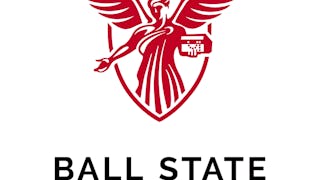Welcome to the Statistical Methods and Data Analysis course! This course serves as an introduction to the statistical and computation methods that have become indispensable tools for those pursuing careers in public policy. Alongside offering the necessary background in basic and applied statistics, the course will also introduce you to the powerful R programming interface.



Was Sie lernen werden
• Explain the basic statistical reasoning involved in data analysis.
• Explain the applications of data analysis with examples from published research.
• Execute the data analysis projects using R.
Kompetenzen, die Sie erwerben
- Kategorie: Statistical Methods
- Kategorie: Statistical Hypothesis Testing
- Kategorie: Descriptive Statistics
- Kategorie: Regression Analysis
- Kategorie: Statistical Inference
- Kategorie: Statistics
- Kategorie: Statistical Modeling
- Kategorie: R (Software)
- Kategorie: Decision Tree Learning
- Kategorie: Big Data
- Kategorie: Correlation Analysis
- Kategorie: R Programming
- Kategorie: Sampling (Statistics)
- Kategorie: Probability
- Kategorie: Random Forest Algorithm
- Kategorie: Probability Distribution
Wichtige Details

Zu Ihrem LinkedIn-Profil hinzufügen
September 2025
29 Aufgaben
Erfahren Sie, wie Mitarbeiter führender Unternehmen gefragte Kompetenzen erwerben.

In diesem Kurs gibt es 8 Module
Statistical methods, by definition, are tools for identifying patterns in large datasets. This module takes the first step towards statistical analysis by exploring various strategies for visualizing data, an increasingly important skill in today’s era of big data. This module explains the different forms of data, types of plots, and charts used to depict the different forms of data. In addition, the module focuses on different visualization techniques appropriate for big data.
Das ist alles enthalten
10 Videos3 Lektüren4 Aufgaben1 Plug-in
While data visualization gives us a ‘first cut’ in the empirical world, knowing what the data ‘looks like’ will not take us far towards identifying relationships between variables — the focal point of policymaking. At the minimum, identification requires that the researcher be able to summarize large amounts of information in the form of descriptive statistics. This module explains the measures of central tendency and dispersion for ungrouped data and for grouped data. The measures of central tendency and dispersion for ungrouped data include mean, median, mode, standard deviation, skewness, and kurtosis. The means of central tendency and dispersion for grouped data include grouped mean, grouped standard deviation, grouped mode, and grouped median.
Das ist alles enthalten
8 Videos1 Lektüre3 Aufgaben
Except in the rarest of cases when data on the entire population is available for all attributes of interest to the researcher, social scientists must draw inferences about a population from a sample drawn from that population. This module focuses on the statistical reasoning involved in studying the uncertainty attached to sample statistics. For making inferences about the population from a sample, the module explains the fundamentals of probability theory. In addition, the module explains the concepts of random variables and function of random variables. Finally, the module covers the concepts and applications of the binomial and normal distributions.
Das ist alles enthalten
9 Videos1 Lektüre5 Aufgaben
This module discusses the various strategies available to researchers for drawing samples from a population and the first principles involved in determining sample size. The module explains the sampling strategies for sampling from a population. In addition, the module explains how to measure the accuracy of sample estimates. Finally, the module focuses on statistical inference. The goal of statistical inference is to make a statement about something that is not observed based on something that is observed, within a certain level of uncertainty. The module will discuss the Central Limit Theorem (CLT) and the concept of the confidence interval, which allow us to make such statements.
Das ist alles enthalten
6 Videos1 Lektüre4 Aufgaben
This module introduces the critical distinction between experimental data and observational data. In addition, the module explores statistical inference in the context of experimental data using tests of significance. You will also learn about observational data and the problem of confounding, controlled experiment, and natural experiment. The module focuses on the concepts and methods for analyzing statistical significance, including analytical framework, one sample t-test, two sample t-test, and ANOVA.
Das ist alles enthalten
8 Videos4 Lektüren3 Aufgaben
This module introduces the foundational model for statistical inference with observational data, namely, the ordinary least squares (OLS) regression, paying particular attention to the conditions under which the OLS estimator is the best linear unbiased estimator (BLUE). You will learn about the concept of association, which helps to understand the relationship between two variables. You will also learn about the measures of association appropriate for each variable type: lambda coefficient for nominal variables, gamma coefficient for ordinal variables, and correlation coefficient for interval-ratio variables. Finally, the module focuses on regression analysis by explaining bivariate OLS and multivariate OLS.
Das ist alles enthalten
8 Videos2 Lektüren4 Aufgaben
This module focuses on advanced modeling strategies in settings where the best linear unbiased estimator (BLUE) assumptions are violated. You will learn about how to get valid ordinary least squares (OLS) estimates when one or the other key assumption on regression errors for OLS estimates to be BLUE is violated. In particular, you will learn how to detect and correct OLS estimates for reverse causality, heteroscedasticity, and serial correlation. Next, under violations of BLUE assumptions on model and variable specification, you will learn how to model nominal and ordinal dependent variables.
Das ist alles enthalten
5 Videos4 Lektüren3 Aufgaben
Running regression models on large-scale datasets with millions of observations and thousands of variables can be a daunting task. This module examines the strategies for building regression models when dealing with such datasets. For conducting big data regression analysis with nominal dependent variables, you will learn the concepts of decision tree, pruning, cross-validation, and random forest. You will also learn about the penalized regression approach, which is useful for running big data regressions when the dependent variable is an interval-ratio variable.
Das ist alles enthalten
5 Videos2 Lektüren3 Aufgaben
Auf einen Abschluss hinarbeiten
Dieses Kurs ist Teil des/der folgenden Studiengangs/Studiengänge, die von O.P. Jindal Global Universityangeboten werden. Wenn Sie zugelassen werden und sich immatrikulieren, können Ihre abgeschlossenen Kurse auf Ihren Studienabschluss angerechnet werden und Ihre Fortschritte können mit Ihnen übertragen werden.¹
Dozent

Mehr von Data Analysis entdecken
 Status: Vorschau
Status: VorschauUniversity of Leeds
 Status: Kostenloser Testzeitraum
Status: Kostenloser TestzeitraumUniversity of Colorado Boulder
 Status: Vorschau
Status: VorschauBall State University
 Status: Vorschau
Status: VorschauUniversity of Leeds
Warum entscheiden sich Menschen für Coursera für ihre Karriere?





Neue Karrieremöglichkeiten mit Coursera Plus
Unbegrenzter Zugang zu 10,000+ Weltklasse-Kursen, praktischen Projekten und berufsqualifizierenden Zertifikatsprogrammen - alles in Ihrem Abonnement enthalten
Bringen Sie Ihre Karriere mit einem Online-Abschluss voran.
Erwerben Sie einen Abschluss von erstklassigen Universitäten – 100 % online
Schließen Sie sich mehr als 3.400 Unternehmen in aller Welt an, die sich für Coursera for Business entschieden haben.
Schulen Sie Ihre Mitarbeiter*innen, um sich in der digitalen Wirtschaft zu behaupten.
Häufig gestellte Fragen
To access the course materials, assignments and to earn a Certificate, you will need to purchase the Certificate experience when you enroll in a course. You can try a Free Trial instead, or apply for Financial Aid. The course may offer 'Full Course, No Certificate' instead. This option lets you see all course materials, submit required assessments, and get a final grade. This also means that you will not be able to purchase a Certificate experience.
When you purchase a Certificate you get access to all course materials, including graded assignments. Upon completing the course, your electronic Certificate will be added to your Accomplishments page - from there, you can print your Certificate or add it to your LinkedIn profile.
You will be eligible for a full refund until two weeks after your payment date, or (for courses that have just launched) until two weeks after the first session of the course begins, whichever is later. You cannot receive a refund once you’ve earned a Course Certificate, even if you complete the course within the two-week refund period. See our full refund policy.
Weitere Fragen
Finanzielle Unterstützung verfügbar,
 enthalten
enthalten
